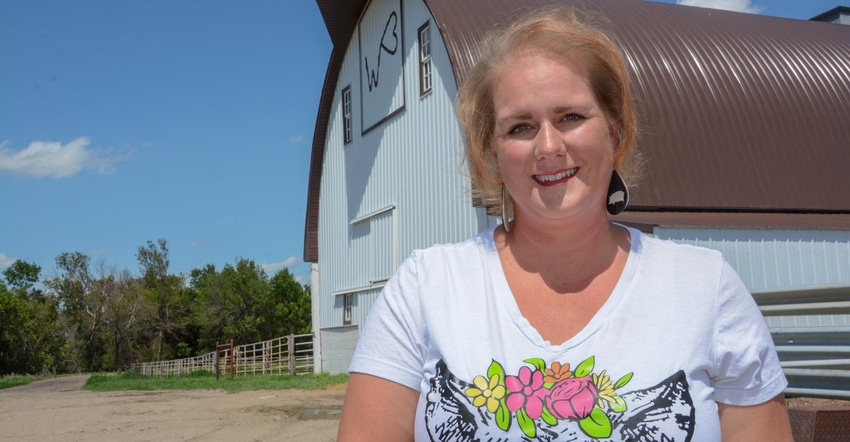
Heather Lang doesn’t try to educate consumers about agriculture with fact and figures. She doesn’t try to advocate for all of agriculture, either.
Instead, the Sterling, N.D., farmer and blogger focuses on telling people how she feels about what she experiences on their farm.
It’s a style that Cyndie Shearing, American Farm Bureau Federation communications director, says is smart, effective and very much needed today.
The Center for Food Integrity research shows that shared values are three to five times more important to building trust with non-farmers and ranchers than sharing facts or demonstrating technical expertise, she says.
And AFBF research shows only one person in five has a high level of trust in modern agriculture, and only about half the population trusts modern ag somewhat, which means they are skeptical.
“This presents farmers and ranchers with a tremendous opportunity to close the gap with consumers,” she says.
Fights like crazy
An example of Lang’s style can be found in one of her one of the blogs titled, “Failure Means You’re Trying”:
“It was a cold October early morning. I had just gotten to the barn to check on a sow that was supposed to farrow soon. She was in her farrowing crate (to keep both her and her babies safe), she had straw, along with heat lamps and heat pads had been plugged in for the piglets (to keep them safe and warm). I walked in that morning to something a farmer never wants to see. She had decided to move all the straw out of her pen, so she was laying directly on the freezing cement floor (we don’t have heated floors in our barn) and gave birth to many piglets on that same freezing cement floor.
“I rushed over to the piglets, swooped them up in my arms, wiped them off, and put them on the heat pad that was under the heat lamps to try to get their body temperature up. After doing so, I went back over to the sow to watch her and noticed she was having trouble. This meant I needed to assist her in birthing the remaining piglets. Because some of the piglets were born on the frigid cement floor before I got there, she gave birth to 16 piglets and nine survived. Was this the outcome we wanted? NO. Was it a failure? Not completely, as we were able to save the sow and the nine that did live.
“I was an emotional wreck afterward. I was mad. I was sad. I was heartbroken. I was tired. I completely understand the circle of life. I understand that things happen. But I often wonder why I get so emotional after losing an animal. Is it because of the cuteness of them? Is it because of all the time, work and energy we put into them? Sure, it is, but to pinpoint exactly why I get so emotional is because it takes me back. I have suffered multiple miscarriages in my adult life, and it made me feel like a failure.
“Failure means you’re trying.” Yes. Hearing that didn’t make it any easier. But you continue to fight.
So, in those moments when I am fighting to keep animals alive, I fight like crazy. I try to make sure I am doing everything within my resources to make sure that our animals are safe and healthy.”
Heart happy
Lang does not write just about hard times, though. In a blog titled “A visit to the farm,” she described the joy she felt in giving a tour of their farm to a group of women and their young children.
“A tractor wagon ride, led by one of our John Deere tractors driven by my father-in-law, took them around our working 5th generation farm. The weather was perfect, the sunshine highlighted the beautiful blue sloughs we have and it was playtime for the calves out in the pasture while their mamas got a bit of a break to rest and chew their cud. Taking [the children and their moms} back in time, I showed them the original farmstead from 1906 that we still have and shared the story of how our farm got the White Heart brand.
“Our three children (the 5th generation on the farm) were overjoyed to show everyone their animals and share information about those animals. It wouldn’t be a farm tour without being able to cuddle actual livestock, right? Everyone spent about an hour in the barn touching the pigs, piglets, a meat goat, dairy goats, horse, and bottle calf; but I think the rabbits were the overall hit, with kids wanting to take them home.
“The moms had plenty of good questions and were very inquisitive. The kids had a blast holding the piglets, letting the goats suck on their fingers and cuddling all the different breeds of rabbits.
“We finished off the day with a small snack and story time on the lawn.
“I had a couple of the moms reach out to me afterwards and tell me how their kids have declared they now want to be farmers when they grow up. That makes my heart happy.”
Direct marketers
Lang and her husband, Lucas, operate White Heart Ranch. They direct market pork and beef and raise barley, flax, oats, canola and other grain crops. Lang also has a wedding decoration business called Forever Fresh, is a local North Dakota Farm Bureau leader, and serves on the AFBF’s Promotion and Education Committee.
Blogging can be hard work, and burnout is common. But not for Lang.
Inspiration usually comes while she sits in the barn and watches the animals. That’s when she writes, shoots videos and post items on social media.
“It’s one of the comforting and relaxing parts of my day,” she says.
Follow Lang on her farm’s Facebook page and check out her other blog posts hosted on North Dakota Farm Bureau’s On Your Table website.
About the Author(s)
You May Also Like






